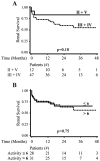Predicting outcomes of lupus nephritis with tubulointerstitial inflammation and scarring
- PMID: 21309006
- PMCID: PMC3106120
- DOI: 10.1002/acr.20441
Predicting outcomes of lupus nephritis with tubulointerstitial inflammation and scarring
Abstract
Objective: In lupus nephritis, glomerular injury correlates poorly with progression to renal failure. While the tubulointerstitium is also commonly involved, the importance of such involvement is not well defined. Therefore, we developed a simple method to assess the prognostic utility of measuring tubulointerstitial inflammation (TI).
Methods: Sixty-eight systemic lupus erythematosus patients with lupus nephritis were enrolled. Tubulointerstitial lymphocytic infiltrates were quantitated both by anti-CD45 antibody staining and standard histochemical staining. Followup data were obtained and survival analysis was carried out to determine which histologic features were predictive of subsequent renal failure.
Results: By CD45 staining, TI was a common pathologic finding, with 72% of biopsies having moderate or severe involvement. The extent of TI correlated with serum creatinine, but not with double-stranded DNA antibodies, serum C3, or glomerular inflammation. TI severity, but not glomerular injury, identified patients at greater risk for renal failure (P = 0.02). A high National Institutes of Health (NIH) chronicity index also identified patients at risk for renal failure. However, when the glomerular and tubulointerstitial subcomponents of the NIH chronicity index were separated in a bivariate model, only tubulointerstitial chronicity provided prognostic information (hazard ratio [HR] 2.2, 95% confidence interval [95% CI] 1.3-3.6; P = 0.002 versus HR 1.0, 95% CI 0.7-1.5; P = 0.97 for glomerular chronicity).
Conclusion: TI identifies lupus nephritis patients at greatest risk for progression to renal failure. The immunologic mechanisms underlying TI may provide novel targets for therapeutic intervention.
Copyright © 2011 by the American College of Rheumatology.
Figures



References
-
- Mok C, Tang SS. Incidence and predictors of renal disease in Chinese patients with systemic lupus erythematosus. Am J Med. 2004;117(10):791–5. - PubMed
-
- Cervera R, Khamashta MA, Font J, Sebastiani GD, Gil A, Lavilla P, Mejia JC, Aydingtug AO, Chwalinska-Sadowska H, de Ramon E, Fernandez-Nebro A, Galeazzi M, Valen M, Mathieu A, Houssiau F, Caro N, Alba P, Ramos-Casals M, Ingelmo M, Hughes GR. European Working Party on Systemic Lupus Erythematosus. Morbidity and mortality in systemic lupus erythematosus during a 10-year period: a comparison of early and late manifestations in a cohort of 1,000 patients. Medicine (Baltimore) 2003;82(5):299–308. - PubMed
-
- Bernatsky S, Boivin JF, Joseph L, Manzi S, Ginzler E, Gladman DD, Urowitz M, Fortin PR, Petri M, Barr S, Gordon C, Bae SC, Isenberg D, Zoma A, Aranow C, Dooley MA, Nived O, Sturfelt G, Steinsson K, Alarcon G, Senecal JL, Zummer M, Hanly J, Ensworth S, Pope J, Edworthy S, Rahman A, Sibley J, El-Gabalawy H, McCarthy T, St Pierre Y, Clarke A, Ramsey-Goldman R. Mortality in systemic lupus erythematosus. Arthritis Rheum. 2006;54(8):2550–7. - PubMed
-
- McLaughlin J, Bombardier C, Farewell VT, Gladman DD, Urowitz MB. Kidney biopsy in systemic lupus erythematosus. III. Survival analysis controlling for clinical and laboratory variables. Arthritis Rheum. 1994;37(4):559–67. - PubMed
-
- Cook R, Gladman DD, Pericak D, Urositz MB. Prediction of short term mortality in systemic lupus erythematosus with time dependent measures of disease activity. J Rheumatol. 2000;27(8):1892–5. - PubMed
Publication types
MeSH terms
Grants and funding
LinkOut - more resources
Full Text Sources
Medical
Molecular Biology Databases
Research Materials
Miscellaneous

